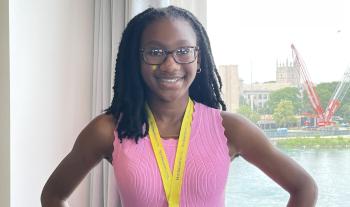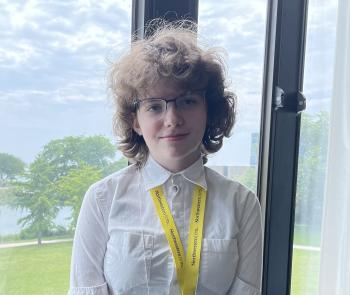Cathy Coughlin Scholars Program Fuels Girls’ STEM Dreams
By Ed Finkel
Kendall Luellen, who hails from Chicago’s South Side and is going into eighth grade this fall at Whitney M. Young Magnet High School’s Academic Center, is spending this summer taking comparative anatomy at CTD. She took biomedicine last summer, pathophysiology in the fall, and plans to study biology and neurology in college and beyond.
Izzy Boylan, who’s from the far South Side of Chicago and will be a freshman at John Hancock College Preparatory High School, is taking medical pharmacology this summer at CTD. She’s taken aerospace engineering and a circuits class called “FUSE Studio Design Challenges” the past couple of summers, and she intends to pursue agricultural science or possibly chemistry.
Luellen and Boylan are two of the fifteen young women currently enrolled in CTD summer courses who are Cathy Coughlin STEM Scholars. The program was established in Coughlin’s memory in 2015 to provide access to advanced, accelerated STEM programming aimed at preparing students for challenging coursework in high school and beyond.
Open to sixth grade girls in the Evanston and Chicago areas with strong interest and aptitude in STEM as well as financial need, the program covers the cost of all tuition and fees and can be renewed for up to three years—covering all summers during middle school, a time when girls sometimes miss out on or drop out of STEM-related activities.

Luellen, who has taken CTD courses since second grade, both summers and Saturdays, became a Coughlin scholar last year. The previous summer, she had taken pre-algebra as a commuter student, which “definitely helped placing me into accelerated algebra at school,” she says. “I wanted the opportunity. I love math and science classes. I’ve gotten to go to Whitney Young, and it’s prepared me for the challenging classes there.”
During her comparative anatomy course, Luellen hopes to learn more about the human body and the specifics of microbiology. Thinking back on her biomedicine class from last year, the highlight for her was the opportunity to dissect both a cow’s eye and a sheep’s brain, which she acknowledges “sounds gross, but it was really cool.” She also presented on Creutzfeldt-Jakob disease and shingles, created model lungs, and developed infographics about diabetes and autism.
But it wasn’t just about the coursework, Luellen says. “It was so much fun being in a college dorm,” she says. “We weren’t only doing schoolwork. On Saturdays and Sundays, we got to go to Six Flags, the Museum of Science and Industry, water parks, and shopping downtown. It was really fun getting to generally have the experience of kind of being in college, eating lunch, being in a dorm, making friends, and doing after-school activities.”

Boylan, who has taken CTD courses for several years and remembers “Fairy Tale Ethics” and the puzzle-solving class “Brainbusters” from earlier in childhood, was drawn to the pharmacology course this summer due to her interest in biology and chemistry; she took honors biology as an eighth grader. And when she and her mom looked at the syllabus, they noticed that the instructor has a PharmD degree, plus “there was immediately a question that I knew how to answer because I learned it in my biology class: ‘How does ibuprofen know you have a headache?’” she says. “It doesn’t know. It just blocks your pain receptors.”
During aerospace engineering last summer, Boylan and her group built a rocket they named “Idiot 3” that went higher than any of their classmates’ projects. In “FUSE Studio” the year before—a class that “fuses” fields like electronics, robotics, biotechnology, architecture, sound mixing and fashion design—Boylan remembers an assignment to correctly wire an LED light, which she incorporated into a replica of the character Sans from the video game Undertale, whose eyes glow whenever he attacks.
The experience was about more than the coursework for Boylan, as well. “I had never been to a three-week residential camp before my first year,” she says. “I made a lot of friends and learned a lot. It changed my life. It’s been really good.”
Both Luellen and Boylan have participated in STEM-related activities outside of CTD, as well. Boylan enrolled in two other weeklong STEM summer camps in 2023. One, at Argonne National Laboratory, covered robots and coding, where she and her classmates got to see the Aurora supercomputer and made robots; she named hers “Marie Curie” after the physicist and chemist, and gave “Marie” sunglasses and a hat made from a red Solo cup.
The second one, at Adler Planetarium, covered the Earth’s atmosphere and culminated in the students sending a weather balloon into the air to track and collect data; they were also able, on the final day, to watch videos that the balloon had collected. This summer, Boylan also will attend a camp at Illinois Institute of Technology called “Fast Cars, Clean Energy.”
Both girls have participated in the Math Circles of Chicago program, which Boylan describes as being “a math symposium which is like a science fair; we made displays, prototypes and presented our math research to judges. CTD helped prepare me for math-related programs and activities, as well.”
Luellen also fulfilled a civics project requirement at Whitney Young by hosting a Minority Girls in STEM event, for girls in her community, in which she led a solar bracelet-making activity, discussed her personal experiences in STEM, and presented on minority women in STEM such as Katherine Johnson, a mathematician whose seminal calculations work for NASA was featured in the movie “Hidden Figures”; and Henrietta Lacks, whose cervical cancer cells proved to be very productive in early cancer research—but which were also taken without her consent, and without any compensation to her family.
Both girls have no doubt that STEM will be part of their futures. “I want to pursue knowledge in neurology, specifically,” Luellen says. “Biomedicine, biology, neurology, stuff like that.” She “definitely” plans to pursue those topics in college and for her career.
“I really, really like science,” Boylan adds. “I like technology and engineering, too. My dad wants me to study agricultural science. It would be a really good job for the future, considering what’s going on” with global warming and climate change. Another possibility is “chemistry, organic or inorganic. I don’t care. I just really like chemistry.”
If you would like to learn more about the Coughlin STEM Scholars or support a future scholar, please visit the CTD Coughlin Scholarship web page or contact us at ctd-school-services@northwestern.edu.

